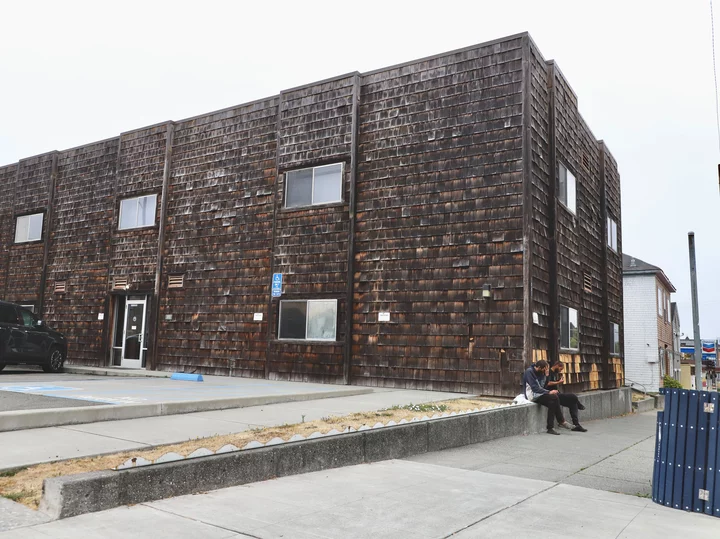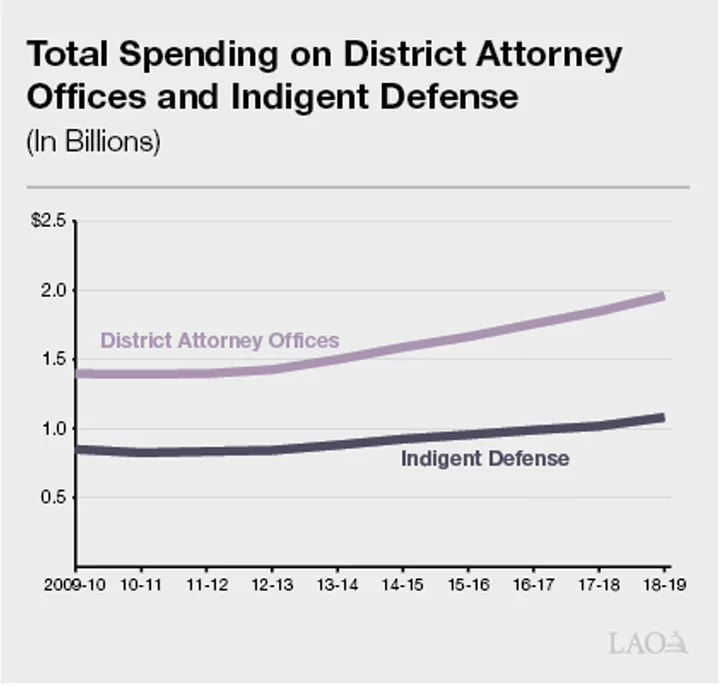The Humboldt County Public Defender’s Office, located at 1001 Fourth Street in Eureka. | Photo by Andrew Goff.
###
PREVIOUSLY
###
Is Humboldt County’s criminal justice system inherently unfair to defendants? The latest report from the county’s Civil Grand Jury concludes that it most certainly is.
Titled “Scales of Justice Out of Balance?” and featuring Fyodor Dostoyevsky’s famous quote about how best to judge a society as an epigraph, the 34-page report finds that while attorneys staff in the Humboldt County Public Defender’s Office excel in their mission to represent indigent clients, they are egregiously overworked and underpaid compared to their counterparts in the District Attorney’s Office — plus they’re forced to work in an “inadequately maintained, infested, sometimes leaking, dilapidated” old building (pictured above).
“Staff experience burnout, secondary traumatic stress, and even physical attacks, with limited resources provided to address these issues,” the report says, “Despite these challenges, the Public Defender’s Office successfully and competently represents their clients, with few client complaints.”
Regarding the workload, the report notes:
Each attorney in the Public Defender and Conflict Counsel’s Office is doing the job of at least 2.5 attorneys based on caseload recommendations from the Office of the State Public Defender. This is without taking into account the complexity of the cases, and does not allow for even a single hour of sick leave, vacation, training or administrative tasks.
(The Conflict Counsel’s Office is part of the PD’s office and also represents indigent clients, though it includes private attorneys. Its attorneys are typically appointed when there’s a conflict of interest in the PD’s Office.)
Meanwhile, the DA’s Office receives about 40 percent more funding than the Public Defender’s Office despite having similar caseloads. Investigators and support staff in the PD’s Office staff make significantly less than their counterparts in the DA’s Office. Humboldt’s PD attorneys also make less than those in other California counties, which makes it tough to recruit and retain new ones.
“The PD has lost experienced and effective attorneys to alcoholism and burnout,” the report says. “One former Deputy Public Defender reported it took two years after leaving the office to recover from the stress and trauma and reach the point of being able to work again.”
As a reminder, Humboldt County’s Civil Grand Jury is an independent body of 19 citizen volunteers tasked with investigating the operations of local government agencies to ensure accountability, efficiency and transparency. For this report, the group interviewed county employees, made site visits, attended court proceedings and reviewed relevant records, laws and policies.
Regarding that ugly box of rotting shingles on Fourth Street, the Civil Grand Jury notes that the county has long planned to consolidate multiple county services into one comprehensive campus, which may explain the reluctance to fix up the PD’s existing office, but those consolidation plans have been repeatedly delayed, most recently because of the county’s budget woes.
As for the pay and resource disparity between the DA and PD offices, the report notes that the problem is not unique to Humboldt. While the American Bar Association says that, as a matter of principle, there should be parity between defense counsel and the prosecution, in reality that’s just not the case.
Consider the chart below, which shows the ratio of District Attorney Office funding versus indigent defense funding for the 32 California counties that reported data for both public defender and district attorney offices.
Data compiled by the California Legislative Analyst’s Office. | From the Grand Jury report.
###
The DA’s Office has other built-in advantages:
Much of what the DA needs to prosecute a case is given to them by law enforcement, including the law enforcement report, witnesses’, victims’ and defendants’ statements and contact information, electronic and physical evidence, and medical and laboratory reports. The PD must put together the defense by itself. The PD conducts its own investigations, and must identify, find and interview all defense witnesses.
The report invokes the Sixth Amendment and says it “seems difficult to justify” the big funding gap between the DA and PD offices, and it concludes that the scales of justice are most certainly out of whack.
Regarding the PD Office’s employees, the report says, “These defenders of justice are disadvantaged, deluged and devalued. They all work stressful jobs, in a demoralizing, decrepit environment, with too few staff, not enough money, little opportunity for advancement, and no hope of relief.
“Is there equity in our local judicial system? There is not,” the report continues. “The one and only advantage the Public Defender’s Office has is its quality, highly skilled, and dedicated staff. Pitted against a Goliath, these Davids are winning battles.”
As with all reports from the Civil Grand Jury, this one concludes with a list of findings followed by a list of recommendations. There are 20 of the latter in this instance. They include relocating the office into better facilities within a year; raise deputy PD wages to a level of parity with deputy DAs; provide more investigatory resources to the office; fund a full-time social worker for the office; allow the employees to bring emotional support dogs to work; and provide funding to hire more support staff.
You can download the full report by clicking here.
###
[CORRECTION: This story initially mischaracterized aspects of the Conflict Counsel’s Office and stated that the pay discrepancy between the DA and PD offices included attorneys. In fact, DA and PD attorneys are members of the same bargaining unit and thus have equal pay. The Outpost regrets the errors.]


CLICK TO MANAGE